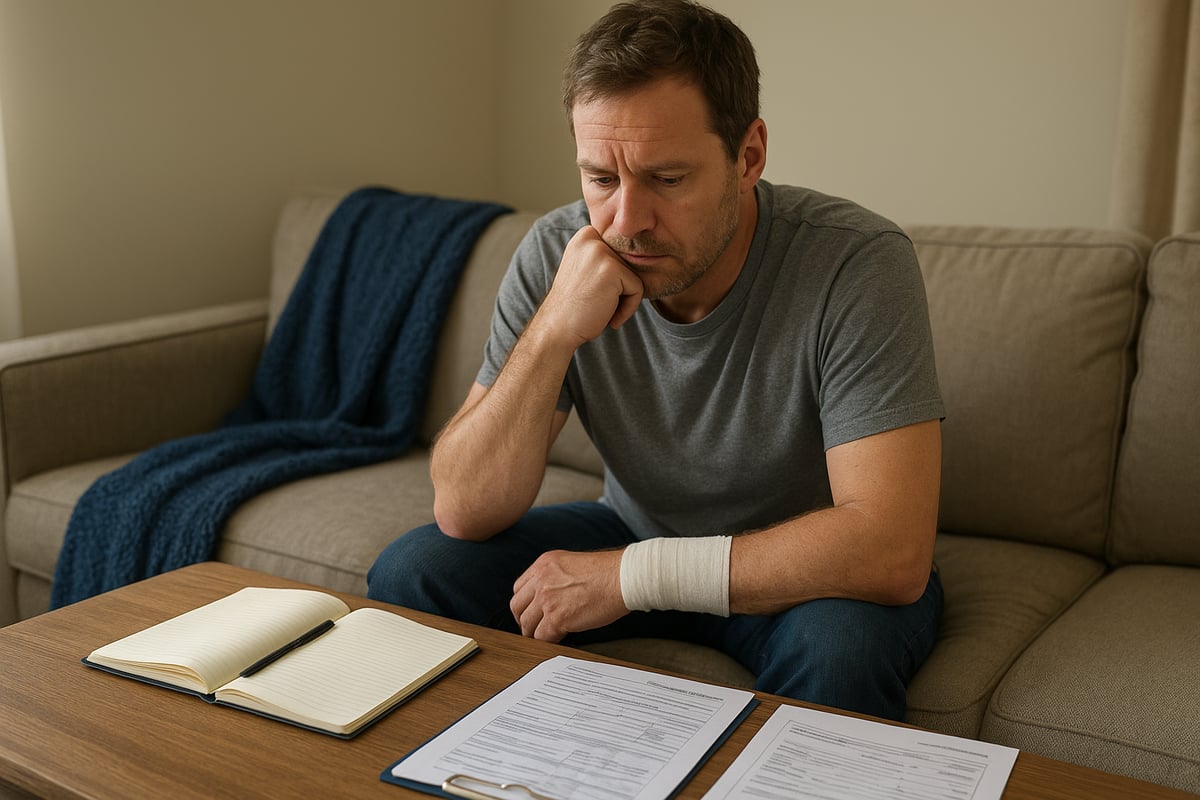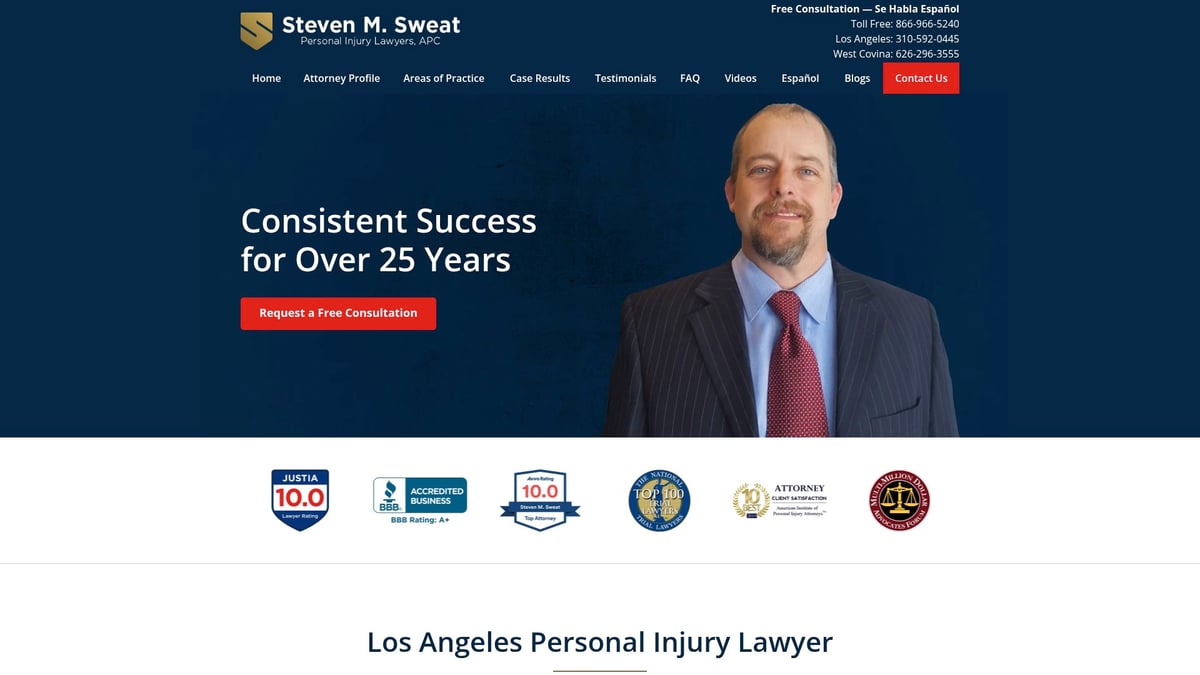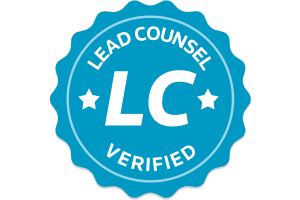- Free Consultation: 866-966-5240 Tap Here To Call Us
Pain and Suffering Settlement Guide: What to Expect in 2025
Facing a pain and suffering settlement can feel confusing, especially as legal standards shift in 2025. Many injury victims find the process daunting, with new rules and trends shaping how compensation is awarded.
This guide breaks down what you need to know about pain and suffering settlement outcomes in the coming year. You will learn about the types of damages, calculation methods, factors that influence settlement value, negotiation strategies, and expected legal changes.
By understanding each step, you can protect your rights and improve your chances of a fair settlement. Follow this guide to approach your claim with clarity and confidence.
Understanding Pain and Suffering in Personal Injury Claims
Navigating a pain and suffering settlement begins with understanding what pain and suffering truly mean in the context of personal injury cases. These damages often shape the value of a claim, going far beyond simple reimbursement for medical bills. For many victims, the pain and suffering settlement is a crucial part of the compensation process, accounting for the deep and personal impacts of an injury.
Defining Pain and Suffering
Pain and suffering refer to the physical and emotional distress a person endures after an injury. This includes not just the immediate pain from the accident but also ongoing discomfort and the psychological toll, such as anxiety or depression. Unlike economic damages, which cover measurable losses like medical bills, pain and suffering damages recognize the subjective impact on a victim’s life.
What sets these damages apart is their focus on the personal experience of the injured party. For example, someone facing long-term mobility issues might lose the enjoyment of activities they once loved. The law acknowledges that every pain and suffering settlement is unique, reflecting the specific ways an injury changes a person’s daily reality. Studies show that non-economic damages, including pain and suffering, can make up a significant portion of total settlements.
Types of Pain and Suffering Damages
A pain and suffering settlement can cover a wide range of non-economic losses. Physical pain includes chronic discomfort, disability, scarring, or disfigurement. Emotional suffering covers psychological effects like PTSD, sleep problems, or a sense of isolation. Loss of enjoyment of life is another aspect, where victims cannot return to hobbies or everyday routines.
These damages also account for impacts on relationships and social life. For instance, missing out on a family milestone due to injury can lead to depression. The law distinguishes between past and future pain and suffering, recognizing that some effects persist long after an accident. Courts have set legal precedents for awarding compensation for various types of suffering, showing the broad scope of what a pain and suffering settlement can address.
Economic vs. Non-Economic Damages
In a pain and suffering settlement, it’s important to differentiate between economic and non-economic damages. Economic damages are straightforward, covering medical expenses, lost wages, and other quantifiable losses. Non-economic damages, on the other hand, refer to intangible losses like pain and suffering or loss of companionship.
Quantifying pain and suffering is more challenging because it lacks a clear monetary value. Juries often play a key role in determining fair compensation for these non-economic harms. For example, a case might involve $10,000 in medical bills, but the jury could award $30,000 for pain and suffering. Comprehensive documentation is essential for both types, as it strengthens the overall pain and suffering settlement claim.
Real-World Examples of Pain and Suffering Settlements
Pain and suffering settlement amounts can vary dramatically based on the details of each case. Take the example of a car accident victim who receives $22,500 for pain and suffering in addition to $7,500 for medical bills, using a multiplier method. Another case might use the per diem approach, awarding $36,600 for six months of recovery.
Settlements often reflect the severity of the injury, the jurisdiction, and the negotiation strategy. Permanent disabilities or visible scars frequently lead to higher awards. For instance, a minor injury might result in a smaller settlement, while catastrophic injuries can lead to much larger amounts. According to average personal injury settlement statistics, non-economic damages like pain and suffering often range from 1.5 to 5 times the economic damages, underscoring their significance in total compensation.
How Pain and Suffering Settlements Are Calculated
Understanding how a pain and suffering settlement is calculated is essential for anyone pursuing compensation after an injury. In 2025, legal trends and technology continue to influence these calculations, making it more important than ever to know your options. Let’s break down the primary methods, exceptions, and the unique roles of insurers and juries.
The Multiplier Method Explained
The most common approach to determining a pain and suffering settlement is the multiplier method. This technique multiplies the total economic damages, such as medical bills and lost income, by a specific factor. The multiplier typically ranges from 1.5 to 5, depending on the severity and long-term impact of the injury.
For example, if your economic damages total $10,000 and the chosen multiplier is 2, your pain and suffering settlement would add $20,000, resulting in a total settlement of $30,000. More severe injuries, such as those causing permanent disability, may justify a higher multiplier.
Courts and insurers consider factors like the length of recovery, ongoing symptoms, and visible scarring. While this method is widely used, critics note it may not always capture the true scope of suffering. For a deeper dive into these calculation techniques, see this guide on pain and suffering calculation methods.
The Per Diem Method
The per diem method assigns a daily monetary value to the pain and suffering experienced. This value is then multiplied by the number of days the victim is affected by the injury. The approach is particularly effective when there is a clear recovery timeline.
For instance, if a daily rate of $100 is established and the recovery period is 180 days, the pain and suffering settlement would total $18,000. Typically, the daily rate is based on the victim’s average daily earnings or another reasonable benchmark.
This method emphasizes the day-to-day impact of the injury. It works best for cases where the duration of suffering is well defined, making the process both transparent and relatable for juries and insurers.
When Standard Methods Don’t Apply
Not every injury is suited to traditional calculation methods. Certain situations, like psychological trauma or permanent disfigurement with modest medical expenses, require a more nuanced approach to a pain and suffering settlement.
In these cases, attorneys may rely on narrative-based valuations, expert testimony, or comparisons to similar cases. For example, a person with minimal medical bills but lifelong visible scars may receive a substantial settlement based on the profound impact on their quality of life.
Courts recognize that some losses cannot be easily quantified. As a result, flexibility in calculation methods allows for fairer compensation when injuries fall outside the norm.
Role of Insurance Companies and Software
Insurance companies play a decisive role in pain and suffering settlement negotiations. Increasingly, insurers use proprietary software to estimate settlement values based on injury details and supporting evidence.
While this technology brings consistency, it can also lead to undervaluing claims, as algorithms may not fully appreciate the human element of suffering. Adjusters often rely on software-generated figures as starting points, making it challenging for claimants to secure higher amounts.
Legal advocacy becomes crucial in these scenarios. An experienced attorney can effectively counter lowball offers by presenting compelling evidence and highlighting aspects the software might overlook.
Jury Discretion and Legal Guidelines
When pain and suffering settlement negotiations fail and cases proceed to trial, juries have significant discretion in determining compensation. Unlike economic damages, there is rarely a strict formula for non-economic losses.
Judges instruct juries to award reasonable compensation for both present and future suffering. This subjectivity means that two similar cases can result in vastly different awards, depending on jury perception and the persuasiveness of the evidence presented.
Attorneys play a vital role in guiding juries to understand the full extent of a client’s suffering. Strong legal arguments and thorough documentation can greatly influence the final award, making careful preparation essential for maximizing a pain and suffering settlement.
Key Factors Influencing Pain and Suffering Settlement Amounts
Navigating a pain and suffering settlement requires a clear understanding of the factors that shape your compensation. Each case is unique, but certain elements consistently influence the outcome. By examining these key factors, you can better anticipate what to expect and prepare effective documentation.
Severity and Duration of Injuries
The seriousness and length of your injuries play a major role in any pain and suffering settlement. Minor injuries like sprains or bruises often lead to lower awards, while catastrophic injuries—such as spinal cord damage or traumatic brain injuries—command much higher compensation.
For example, settlements for spinal cord injuries are typically higher because the impact is lifelong and affects every aspect of daily living. The longer your pain lasts or the more severe it is, the greater the settlement value. According to Personal injury settlement statistics 2025, cases involving permanent disabilities or chronic pain can result in multipliers at the top of the scale.
Data consistently show that the most severe cases receive the largest awards. This makes thorough medical documentation and evidence of ongoing symptoms essential for maximizing your pain and suffering settlement.
Impact on Daily Life and Activities
How your injuries disrupt daily routines and activities will also affect your pain and suffering settlement. If you can no longer work, participate in hobbies, or care for your family, your claim is stronger.
You should keep a journal that details missed events, lost opportunities, and changes in your lifestyle. Photos and witness statements from friends, family, or colleagues can further support your claim. For instance, an athlete unable to return to their sport may receive a higher settlement because their quality of life and identity are closely tied to that activity.
These lifestyle impacts are often just as important as the physical injury itself when evaluating the pain and suffering settlement.
Age, Occupation, and Pre-Existing Conditions
Your age, job, and any pre-existing health issues can significantly influence your pain and suffering settlement. Younger claimants may be awarded higher settlements, reflecting the longer duration of suffering ahead. Similarly, if your career is physically demanding, an injury that limits your ability to work can increase your compensation.
Pre-existing conditions can complicate the calculation, as insurance companies might argue that some of your pain relates to old injuries. Still, if the new injury worsens your condition or creates additional limitations, it should be factored into the pain and suffering settlement.
For example, a professional dancer with a foot injury may receive more than an office worker, as the injury affects their livelihood and passion.
Jurisdictional Laws and Damage Caps
Where your case is filed can have a direct impact on your pain and suffering settlement. Each state has its own laws, and some impose caps on non-economic damages like pain and suffering. These limits can significantly reduce the potential settlement, especially in medical malpractice cases.
Jury attitudes and local legal precedents also play a role. For instance, California may allow higher non-economic damages in some cases compared to states with stricter caps. Understanding your jurisdiction’s rules is crucial for setting realistic expectations for your pain and suffering settlement.
Strength of Evidence and Legal Representation
The quality of your evidence and the expertise of your legal team are critical to the outcome of your pain and suffering settlement. Detailed medical records, expert testimony, and credible witness statements all strengthen your position.
Experienced personal injury attorneys know how to present your case, negotiate effectively, and push back against low settlement offers. Comprehensive evidence and skilled representation can make the difference between a minimal offer and a fair, substantial pain and suffering settlement.
Step-by-Step Guide to Maximizing Your Pain and Suffering Settlement in 2025
Navigating a pain and suffering settlement in 2025 requires careful planning and attention to detail. The following steps will help you strengthen your claim, improve your documentation, and put you in the best position to receive fair compensation. Let’s break down each step in the process.
Step 1: Seek Immediate Medical Attention and Follow Treatment
The first move in maximizing your pain and suffering settlement is to seek prompt medical care after your injury. Immediate treatment not only protects your health but also creates vital documentation. Medical records serve as the foundation for proving the extent of your injuries and the impact on your daily life.
Always follow your doctor’s instructions and complete prescribed therapies. Gaps in treatment or missed appointments can suggest that your injuries are less severe, leading to lower settlement offers. Remember, a pain and suffering settlement relies heavily on credible medical evidence.
If you delay seeking care, insurers may argue your injuries are unrelated or exaggerated. Consistency in treatment shows you are taking your recovery seriously and supports your claim for appropriate compensation.
Step 2: Document Your Physical and Emotional Suffering
Careful documentation is essential for a successful pain and suffering settlement. Start by keeping a daily pain journal. Record your symptoms, pain levels, emotional struggles, and how the injury affects your daily activities.
Photograph visible injuries and changes in your physical appearance throughout your recovery. Ask family, friends, and coworkers to provide statements about your limitations or emotional changes. This evidence helps demonstrate both the physical and emotional impact of your injury.
For example, if you miss an important family event due to pain, note the emotional toll. These details provide compelling proof of your pain and suffering and can influence the final settlement amount.
Step 3: Preserve All Economic and Non-Economic Evidence
To maximize your pain and suffering settlement, keep thorough records of all related expenses. Save every medical bill, prescription receipt, and proof of lost income. Organize these documents for easy reference during negotiations.
In addition to economic losses, gather evidence of non-economic damages. This includes your pain journal, photos, and any correspondence with healthcare providers. Comprehensive documentation strengthens your claim and supports your request for higher compensation.
A well-organized file makes it easier to justify your pain and suffering settlement demand, showing insurers or juries the full impact of your injury.
Step 4: Be Cautious with Insurance Communications and Social Media
Insurance adjusters may contact you soon after an injury, asking for statements or offering quick settlements. Be careful: what you say can be used to minimize your pain and suffering settlement. Avoid recorded statements without consulting an attorney.
Be mindful of your social media presence. Photos or posts suggesting you are active or pain-free can be used to dispute your claim. Insurers routinely review online profiles for evidence that contradicts your reported suffering.
Always consult with your attorney before sharing information with insurance companies or online. Protecting your privacy helps preserve the value of your pain and suffering settlement.
Step 5: Engage an Experienced Personal Injury Attorney
Having a skilled attorney can make a significant difference in your pain and suffering settlement. Legal professionals understand the nuances of personal injury law and can accurately calculate both economic and non-economic damages.
An attorney will gather vital evidence, handle negotiations, and advocate for your best interests. Studies show claimants with legal representation often receive higher settlements than those who go it alone. For guidance on evaluating and maximizing your claim, consider a Free evaluation of personal injury claims.
Choose an attorney with experience handling cases similar to yours and a track record of success in pain and suffering settlement negotiations.
Step 6: Negotiate Strategically and Consider Mediation
Negotiation is a critical stage in securing a fair pain and suffering settlement. Initial offers from insurers are typically low, expecting you to negotiate for more. Be prepared to present your documentation clearly and justify your demand.
If negotiations stall, mediation can provide a path to resolution without a lengthy trial. A neutral mediator helps both parties reach a compromise, often resulting in a faster and less stressful outcome.
Remember, patience and persistence are essential during negotiations. Each pain and suffering settlement is unique, and a strategic approach can help you achieve the compensation you deserve.
Working with a Los Angeles Personal Injury Law Firm
Navigating a pain and suffering settlement in Los Angeles requires the guidance of attorneys who understand California’s unique legal landscape. Steven M. Sweat, Personal Injury Lawyers, APC, brings over 25 years of proven success helping clients secure fair outcomes.
The firm handles a wide range of cases, including car accidents, catastrophic injuries, and wrongful death. Their team offers a free consultation, works on a contingency fee basis, and provides multilingual support. For those dealing with car accident injuries, their car accident claims in California resource is especially valuable.
With an award-winning team and hundreds of millions recovered, partnering with a local specialist can make a significant difference in your pain and suffering settlement outcome.
Pain and Suffering Settlement Trends and What to Expect in 2025
Understanding the direction of pain and suffering settlement trends is crucial for claimants preparing for 2025. As legal, technological, and economic landscapes shift, knowing what to expect can help you secure fair compensation. This section explores the most important changes and offers actionable tips for navigating the evolving process.
Evolving Legal Standards and Legislative Changes
The landscape for pain and suffering settlement continues to evolve as lawmakers and courts address fairness and transparency. In 2025, several states are reviewing or updating laws that govern non-economic damages. Some jurisdictions are considering increases to existing caps, while others are re-examining how pain and suffering compensation is calculated.
Transparency is a growing trend. Courts and legislatures aim to ensure that pain and suffering settlement outcomes are more consistent across similar cases. This push often leads to clearer guidelines for juries and negotiators. For example, in California, ongoing debates focus on whether current caps limit fair compensation, especially for severe injuries.
If you are filing a claim, it is essential to understand how your state’s rules may affect your pain and suffering settlement. For a comprehensive overview of state-specific limits, consult this summary of non-economic damages caps by state. Staying informed about these changes can help you and your attorney pursue the maximum possible recovery.
Legal reforms may also introduce new calculation methods or adjust how evidence is weighed. These updates could impact both the value and predictability of pain and suffering settlement awards in 2025.
Technological Advances in Claims Evaluation
Technology is rapidly transforming how pain and suffering settlement values are determined. Insurance companies increasingly rely on artificial intelligence and proprietary software to review claims and assign compensation amounts. These tools analyze medical records, accident details, and other data to estimate appropriate awards.
While technology can speed up the claims process, it is not without drawbacks. Automated systems may overlook the unique aspects of your pain and suffering, leading to undervalued settlements. Some claimants find that their lived experience is not fully captured by algorithms.
Because of these challenges, human advocacy remains vital. Personal injury attorneys can supplement technical evaluations with compelling narratives and evidence, ensuring that the pain and suffering settlement reflects your actual losses rather than a generic formula.
Societal Attitudes and Jury Perspectives
Public perception plays a significant role in pain and suffering settlement outcomes. In recent years, high-profile cases have influenced how juries view non-economic damages, sometimes resulting in larger awards for plaintiffs.
Media coverage and advocacy have increased awareness of the profound impact that injuries can have on daily life. As a result, juries may be more sympathetic when evaluating pain and suffering claims. However, outcomes vary widely by region and jury pool.
It is important to remember that pain and suffering settlement amounts are still subject to individual jury interpretation. Presenting clear, honest evidence of your experience can help ensure a fair evaluation, even as societal attitudes shift.
Insurance Industry Practices and Settlement Strategies
Insurance companies are adapting their strategies in response to rising costs and more sophisticated analytics. Many insurers now scrutinize pain and suffering settlement claims more closely, using data-driven tools to assess value and identify patterns in injury reports.
There is also a trend toward early settlements and alternative dispute resolution methods, such as mediation, to avoid lengthy litigation. For claimants in California, understanding how insurance companies approach California car insurance accident disputes can be critical to negotiating a fair pain and suffering settlement.
Insurers may offer quick, low-ball settlements in hopes that claimants will accept less than they deserve. Strategic negotiation, strong documentation, and legal representation remain essential for maximizing your pain and suffering settlement.
Impact of COVID-19 and Economic Factors
The effects of COVID-19 continue to influence pain and suffering settlement timelines and amounts. Court backlogs have led to longer waits for trials and hearings, prompting many parties to settle out of court.
Economic pressures affect both claimants and insurers. Some individuals, facing financial hardship, may feel compelled to accept lower settlements. On the other hand, insurers are more cautious, carefully evaluating the legitimacy and value of each pain and suffering settlement request.
Additionally, pandemic-related stress has heightened awareness of emotional suffering, sometimes leading to higher non-economic awards. Staying patient and persistent is key to achieving a fair outcome in this environment.
Preparing for the Future: Tips for Claimants in 2025
To succeed with a pain and suffering settlement in 2025, stay informed about legal changes and evolving trends. Keep detailed documentation of your injuries, symptoms, and daily challenges. Consult with an experienced attorney who understands the latest developments. Adaptability and proactive negotiation will be your greatest assets.
As you look ahead to navigating pain and suffering settlements in 2025, having the right guidance can make all the difference. Understanding your rights, documenting your experiences, and staying updated on evolving legal standards are essential steps—but you do not have to do it alone. If you are facing uncertainty about your claim or want to maximize your compensation, we are here to help. Our Los Angeles team brings decades of experience and local expertise to every case, offering support you can count on from start to finish. Let us review your situation with a Free Consultation No Fee Until We Win—your peace of mind starts here.












